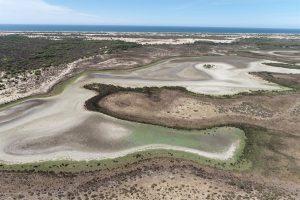Llega el mes de septiembre con una noticia devastadora: desaparece la laguna permanente más grande del Parque Nacional y Natural de Doñana (Andalucía).
Este espacio natural protegido abarca las provincias de Huelva, Sevilla y Cádiz en la Comunidad Autónoma sureña.
El Consejo Superior de Investigaciones Científicas (CSIC) ha comunicado en este inicio de septiembre que, tras mantener una mínima cantidad de agua en agosto, la laguna de Santa Olalla ha terminado por secarse.

Gamos y flamencos en la laguna. ©Luis Serrano
Este fenómeno tiene graves repercusiones en el espacio natural, especialmente para su fauna. La laguna ha sido históricamente un refugio para aquellas aves limícolas que, tras criar en el norte de Europa, migraban al sur. Además, en verano, estas aves acuáticas encontraban en los arrozales un refugio importante.
Una de las causas de la sequía es la crecida exponencial de personas de localidades cercanas que aumenta la cantidad de habitantes de manera exponencial en temporada de verano.
Eloy Revilla, director de la Estación Biológica de Doñana señaló que este acontecimiento ha tenido lugar por tercera vez en la historia, siendo 1983 y 1995, los otros períodos de sequía intensa. Por otro lado, también apunta que Doñana lleva diez años consecutivos con niveles de precipitación inferiores a la media. Este hecho, sumado a la sobreexplotación acuífera y la obtención ilegal del recurso, ha provocado, finalmente, la desaparición total de la laguna.

Estado actual. ©NationalGeographic.
Como se puede observar, este acontecimiento no se trata de un hecho aislado, sino que afecta de manera directa a la flora y fauna que rodea este espacio natural protegido, haciendo cada vez más evidente, la necesidad de un cambio radical en las actitudes y comportamientos generales de la sociedad hacia el cuidado de nuestro planeta.
__
SANTA OLALLA LAGOON IN DOÑANA DISAPPEARS: DROUGHT AND OVEREXPLOITATION OF WATER RESOURCES
September arrives with devastating news: the largest permanent lagoon in the Doñana National and Natural Park (Andalucía) disappears.
This protected natural area covers the provinces of Huelva, Sevilla and Cadiz in the southern Autonomous Community.
The Consejo Superior de Investigaciones Científicas (CSIC) has communicated at the beginning of September that, after maintaining a minimum amount of water in August, the Santa Olalla lagoon has finally dried up.
This phenomenon has serious repercussions for the natural space, especially for its fauna. The lagoon has historically been a refuge for those waders that, after breeding in northern Europe, migrated south. In addition, in summer, these waterfowl found an important refuge in the rice fields.
One of the causes of the drought is the exponential increase in the number of people from nearby towns, which increases the number of inhabitants exponentially in the summer season.
Eloy Revilla, director of the Biological Station of Doñana pointed out that this event has taken place for the third time in history, being 1983 and 1995, the other periods of intense drought. On the other hand, he also points out that Doñana has been experiencing below-average precipitation levels for ten consecutive years. This fact, added to the overexploitation of the aquifer and the illegal extraction of the resource, has finally caused the total disappearance of the lagoon.
As can be seen, this event is not an isolated fact, but directly affects the flora and fauna surrounding this protected natural area, making it increasingly evident the need for a radical change in the general attitudes and behavior of society towards the care of our planet.
__

